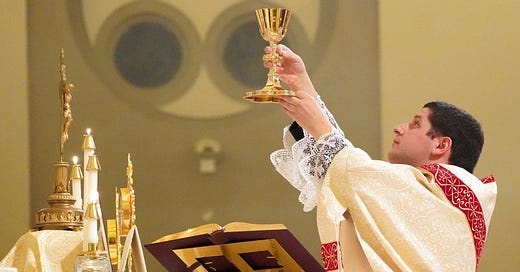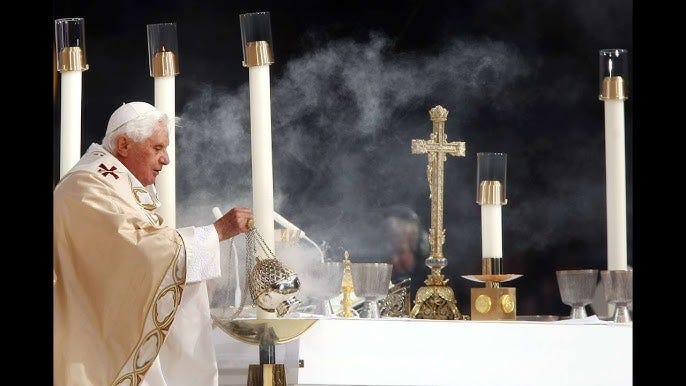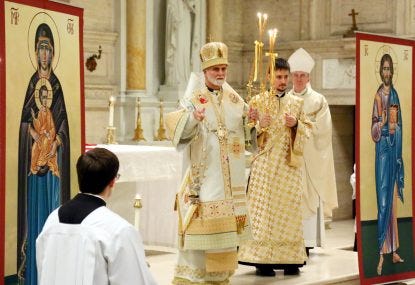The Diocese of Charlotte has gained national attention with the way Bishop Michael Martin has gone about restricting the practice of the Traditional Latin Mass (TLM) in line with Pope Francis' 2021 motu proprio Traditionis Custodes. Martin defended his actions by arguing that his new policy is designed to “promote the concord and unity of the Church." While I know that many of my Substack subscribers would like me to join in the criticism of Bishop Martin, I believe we need to transcend the dialect and recognize that there is a solution to this problem that could lead to a deeper appreciation of praying and singing in Latin that extends far beyond the Diocese of Charlotte.
Having taught the History of Liturgy and the Theology of Liturgy in a major seminary that has since closed, I recall saying to the diocesan seminarians and Franciscan brothers that, had I been a bishop in 1969 when Pope Paul VI promulgated the Novus Ordo, I would have implemented the liturgical changes in my diocese differently than most bishops at that time. Instead of having my priests celebrate all the Masses in Latin using the Tridentine Roman Missal of 1962, and then celebrate all the Masses in English using the Novus Ordo, I would have begun by having them celebrate some of the Sunday Masses in English using the Novus Ordo, while having them celebrate other Masses in Latin using the Novus Ordo. I would recommend that they continue to use Gregorian Chant and incense at the Masses in Latin while helping them to introduce new inspiring hymns at the Masses in English. In time, the percentage of Masses in English and in Latin could be determined by the pastors based on attendance.
Unfortunately, when dioceses transitioned from Masses in Latin to Masses in English using guitars and music with lyrics like, “Eat His Body, Drink His Blood, and we’ll sing a song of Love,” many people did not find themselves inspired by the new liturgy. It was this understandable dissatisfaction with the loss of the sense of transcendence at Mass that moved some Catholics to request permission to celebrate Mass in Latin using the Tridentine Roman Missal. Personally, I do not believe this request would have been made had an adequate number of Masses continued to have been celebrated in Latin using the Novus Ordo with inspiration and a sense of transcendence provided by Gregorian Chant and incense.
Instead of encouraging parishes to offer the option of Mass in Latin using the Novus Ordo, Pope Benedict XVI relaxed restrictions, dating back to the Second Vatican Council, on the use of the Traditional Latin Mass (TLM). With Benedict’s 2007 motu proprio Summorum Pontificum, the TLM became known as the Extraordinary Form of the Roman Rite. The Ordinary Form using the Novus Ordo, and the Extraordinary Form using the TLM of the Roman Rite dating back to the Council of Trent with the latest tweak coming in 1962, were confirmed as two distinct, yet both valid, ways of celebrating Mass.
In 2021, Pope Francis issued a motu proprio Traditionis Custodes which required priests to seek permission from their bishops to celebrate the traditional rite, and bishops to seek Vatican approval. The pontiff, viewing the TLM as a threat to unity, argued that Benedict’s reform had become a source of division in the church and been exploited by Catholics opposed to the Second Vatican Council. Many Catholics who believed their faith was strengthened by their participation in the TLM, objected to Francis’ directive which, in their opinion, did not foster unity, but division in the Church.
The Catholic Church is composed of 24 rites or autonomous Churches; one of which is the Roman Catholic Church, and 23 of which are the Eastern Catholic Churches, also known as Eastern Rite Catholic Churches. While these rites have their own distinct liturgical traditions, they all share the same core beliefs. There is a lesson that Roman Catholic supporters of the TLM can learn from Eastern Rites which celebrate their particular liturgies using one form in different languages (e.g., Greek, Arabic, Slovak, Ukrainian, etc.). In an effort to transcend the dialectic that is currently taking place, I propose that the Roman Catholic Church follow the lead of the Eastern Churches and use one form (i.e., the Novus Ordo) and offer it both in the vernacular and in Latin.
While Jesus spoke Aramaic and understood Greek and Hebrew, he said most of his prayers in Hebrew. While very few Roman Catholics speak Aramaic, Greek, or Hebrew, there are many Catholics throughout the centuries whose faith in God was strengthened by praying and singing in Latin, not to mention Greek. Because very few Catholics speak Latin, most will not catch the differences in the prayers the priest alone prays in the TLM compared to the Novus Ordo. Almost all of the recited and sung parts of the Mass involving the laity are the same in both the Novus Ordo and the TLM which do not need to be translated such as “Alleluia” from the Hebrew for “Praise the Lord;” Kyrie Eleison from the Greek for “Lord, have mercy;” and Pater Noster from the Latin for “Our Father.” I believe the liturgical experience for many Traditional Catholics can be as inspiring in celebrating the Novus Ordo in Latin as attending the TLM. For one to appreciate and understand this, one simply has to attend Mass in St. Peter’s Basilica, celebrated in Latin using the Novus Ordo, with the Sistine Chapel Choir providing musical accompaniment.
As a graduate priest in residence at the North American College in Rome, I often celebrated the Eucharist in Latin using the Novus Ordo whenever I offered Mass in St. Peter’s Basilica with an international group of congregants. Just as I didn’t need permission to celebrate Mass in Latin using the Novus Ordo, the same applies to every priest and bishop throughout the world today. Can you imagine if multiple parishes throughout the world were to offer Mass in Latin using the Novus Ordo complete with Gregorian Chant along with incense that is used in most Eastern Rite liturgies? Even if the Masses were not celebrated ad orientem, would this not be spiritually more beneficial than having the TLM offered at just a few designated sites only a few times a month? If I were not a cancelled priest for exposing abuse and cover-ups by my ecclesiastical superiors, and if I pastored one of the two large Catholic parishes in my town, I would begin by celebrating one of the five weekend Masses in Latin using the Novus Ordo with the scripture readings in English and accompanied by Gregorian Chant. What everyone reading this article needs to know is that a priest is not required to seek permission from his bishop, a Roman dicastery, or even Pope Leo XIV to celebrate the Eucharist in Latin using the Novus Ordo.
Let us pray that the Holy Spirit may help us grasp the significance of “Lex Orandi, Lex Credendi,” i.e., how our prayer life strengthens our faith, and how our faith is strengthened by our prayer life. Let us also pray that the pope, bishops, priests, and laity may appreciate how professing our faith in different languages does not threaten the unity of the Church, but can unite fellow Catholics around the world today with those who have come before us who now make up the communion of saints.
This Substack column is free. If you find it informative, please recommend it to others and consider supporting it by contributing to the “Save Our Seminarians” Fund.
Gene Thomas Gomulka is a sexual abuse victims’ advocate, investigative reporter, and screenwriter. A former Navy (O6) Captain/Chaplain, seminary instructor, and diocesan Respect Life Director, Gomulka was ordained a priest for the Altoona-Johnstown diocese and later made a Prelate of Honor (Monsignor) by St. John Paul II. Email him at msgr.investigations@gmail.com.








You can always find these abuses like this, just like you can identify predator priests who don't represent ALL priests. How about if I were to post a video of a Christmas Midnight Mass celebrated by Pope JP II in Latin using the Novus Ordo in St.Peter's Basilica?
After reading some of the comments above, I want to make it clear that I grew up with the TLM which was only replaced by the Novus Ordo (NO) one year before I graduated from college. Because I celebrated Mass in Latin using the NO in Rome and in other parts of the world, I appreciated the fact that Catholics from different countries from all over the world had no problem following the Mass. Most Catholics in the world today never attended a TLM. While the 15-20 minute daily “low mass” in Latin was not very inspiring, people like myself who grew up serving Mass and memorizing the prayers at the foot of the altar in Latin miss the “high Masses” complete with Gregorian Chant and incense. When people from different countries go to Rome and attend Mass in St Peter’s Basilica, they can all follow it easily because it’s the same NO Mass they have at home only now in Latin. Attending a TLM Mass today for many Catholics could be as foreign to them as if they attended an Eastern Rite Mass in Greek, Ukrainian, Arabic, etc. How many people heard, “It was nice to be able to go to church in that foreign country and be able to follow the Mass”?